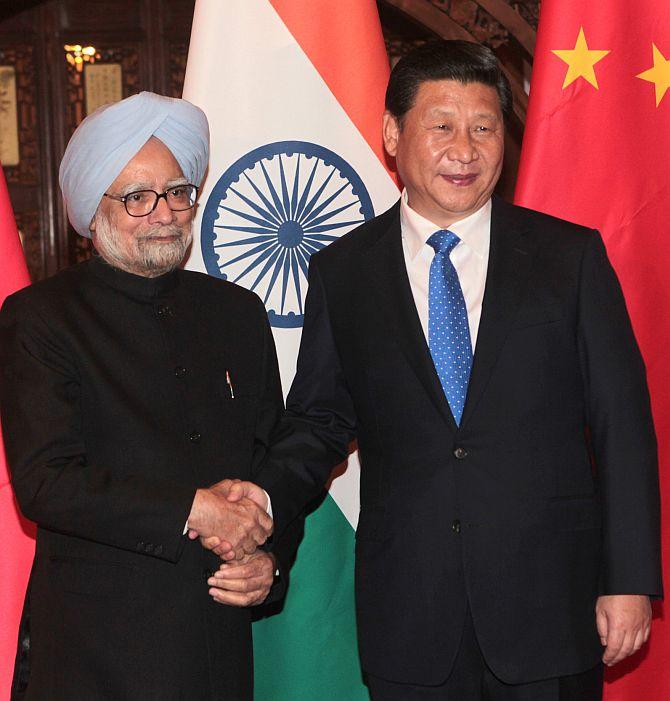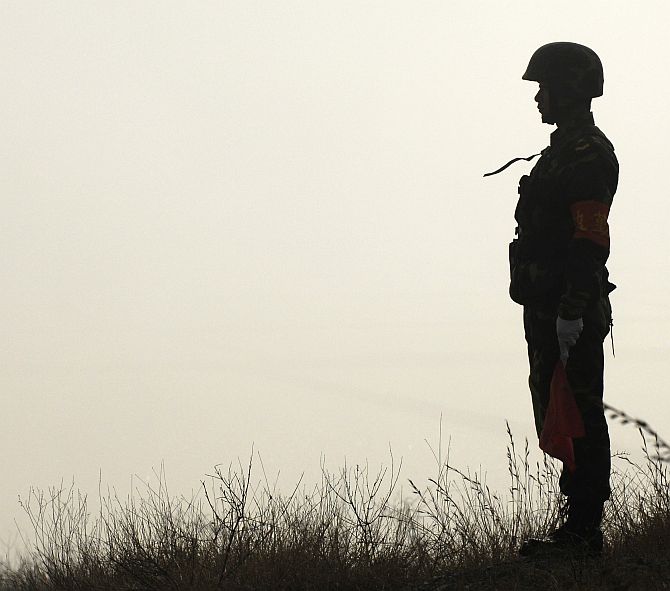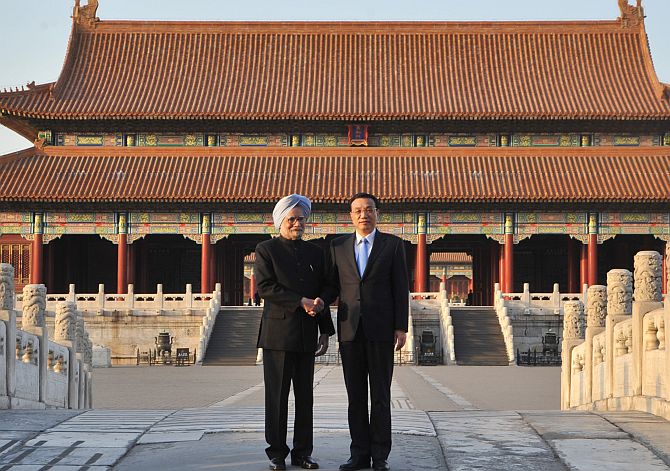
Will the Border Defence Cooperation Agreement, India and China signed in Beijing on Wednesday, end repeated Chinese intrusions into Indian territory? China expert Srikanth Kondapalli explains why he is not hopeful.
Prime Minister Manmohan Singh’s visit to Beijing yielded, as expected, a Border Defence Cooperation Agreement, BDCA, with China. <./p>
Although short on details and mostly repetitive of previous agreements between the two countries, the BDCA has potential new openings in bilateral relations.
Firstly, the expectations in India after the Depsang Plains incident of April 15-May 6 this year when Chinese military personnel marched 19 kilometres inside Indian claimed territory are that both sides need to usher in effective mechanisms for border stability and that the two nuclear neighbours should quickly de-escalate.
As the Chinese side had not given any explanation to the Indian side on why such an incident occurred despite a 'strategic and cooperative partnership' between the two countries, as External Affairs Minister Salman Khurshid and National Security Advisor Shivshankar Menon indicated after their visits to Beijing in May and June respectively, the BDCA could provide for some comfort in putting across and strengthening institutional mechanisms on the borders.
As Dr Manmohan Singh stated at the press conference during Premier Li Keqiang’s visit to Delhi in May and reiterated in Beijing on Wednesday about the 'strategic benchmark. that 'peace and tranquility on our borders must remain the foundation for growth' in bilateral relations.
Secondly, unlike the 1993 'peace and tranquility' agreement which for the first time suggested 'no use of force' by both sides or the 1996 confidence building measures in the military agreement which specified the interactions between border personnel of the two countries, the current BDCA suggested the possibility of 'establishing a Hotline between the military headquarters,' initiating 'small scale tactical exercises along the Line of Actual Control' and 'joint military training exercises.'
...

A hotline exists between the two premiers since November 2010, but the current proposal is between the higher military commands. Also, both armies have been involved in low key 'joint operations' such as the 'hand-in-hand' operations at Kunming in 2007 and Belgaum in 2008, but the current proposal wishes to elevate such interactions.
If both armies go ahead in future with 'tactical exercises,' then there could be substantial changes in the way each deals with the other as field operational principles need to be exchanged, examined and implemented.
Yet, like the November 2002 Declaration on the South China Sea, the BDCA is largely non-binding and mostly dependent on the 'goodwill' of the other side and significantly on the vagaries of the power relations between the two countries.
For, the idea of a status quo on the borders pending the settlement of the dispute came up for the first time three decades ago at the 4th border talks at Delhi in October 1983.
Subsequently, the next 5th meeting at Beijing in September 1984 suggested 'maintaining peace and tranquility' across the Line of Actual Control. Nevertheless, these did not yield many concrete results on the borders between the two countries.
Also, at the second meeting of the Joint Working Group in New Delhi in September 1990, it was proposed that to enhance peace and tranquility in the border areas, the local military head's role was emphasised as they knew the terrain well.
Indeed, the idea of hotlines came up at the 4th JWG meeting in Delhi in February 1992 along with the local military personnel meeting at Bumla in the Eastern Sector and Spanggur in the Western Sector in June and October every year.
Subsequently, at the 9th JWG meeting in Beijing in October 1996, two more annual military meeting points at Lipulekh in the Central Sector and Dichu in the Eastern Sector at the Major General level was finalised.
Yet, as we witnessed, after the April 15 to May 6, 2013 incident at Depsang Plains, it took five flag meetings and the higher political leadership’s intervention from New Delhi to vacate China’s military personnel. This indicated that despite the BDCA, a similar border incident could happen again between India and China.
...

Again, the 1996 CBMs agreement was more comprehensive and extensive than the current BDCA, although again that was not followed in letter and spirit.
For instance, at the 8th meeting of the border talks in Delhi after the Samdurong Chu incident, the Chinese suggested a demilitarised zone in the Eastern Sector, while they were silent on any such proposal for the Western Sector in which Chinese troops were mobilised.
Later, at the 7th JWG meeting in Beijing in July 1994, troop reduction across the Line of Actual Control was made. Next year at the 8th JWG meeting in Delhi in August 1995 the Chinese side suggested that there should be the withdrawal of troops from four forward military posts in the Wangdong area. The Indian side insisted that this should be done across the Line of Actual Control.
Nevertheless, it was reported that the Indian side demobilised nearly 37,000 troops, sending these personnel mainly for counter-insurgency operations in the Kashmir valley. China did not announce any demobilisation on its side, giving rise to a situation of 'unequal security' on the border areas.
To this day, some in India rue that Indian demobilisation led to China occupying those areas vacated by Indian troops such as at Khurnak fort in the Western Sector.
Also, Prime Minister Singh made a 'strategic reassurance' pledge towards China on Wednesday that 'the relationships pursued by India and China with other countries must not become a source of concern for each other.' This is in light of the Chinese agreement with Pakistan to supply nuclear reactors and technology of the construction of the Chashma III and IV projects and India’s growing economic and strategic ties with the United States and Japan.
This is also in light of Dr Singh’s comments to the then Chinese president Hu Jintao in March 2012 that India has no plans to contain China while developing relations with the US. Nevertheless, no such 'strategic reassurance' is forthcoming from Beijing towards New Delhi.
Srikanth Kondapalli is Professor in Chinese Studies at the Jawaharlal Nehru University, New Delhi.